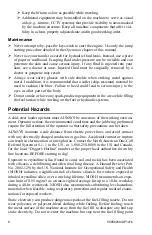
50950260/AP1216
7
SEAT OR LOADER, RESULTING IN DEATH OR SERIOUS INJURY.
Therefore: ALWAYS operate with the seatbelt fastened and the restraint bar
lowered. Do not exceed the machine’s Rated Operating Capacity. Carry the
load low. Move the controls smoothly and gradually, and operate at speeds
appropriate for the conditions.
When operating on inclines or ramps, always travel with the heavier end of
the loader toward the top of the incline for additional stability.
Do not raise or drop a loaded bucket or fork suddenly. Abrupt movements
under load can cause serious instability.
Never activate the float function with the bucket or attachment loaded or
raised, because this will cause the lift arm to lower rapidly.
Do not drive too close to an excavation or ditch; be sure that the surrounding
ground has adequate strength to support the weight of the loader and the load.
Never carry riders. Do not allow others to ride on the machine or attachments,
because they could fall or cause an accident.
Always look to the rear before backing up the skid-steer loader.
Operate the controls only from the operator’s seat.
Always keep hands and feet inside the operator’s compartment while oper-
ating the machine.
New operators must operate the loader in an open area away from bystanders.
Practice with the controls until the loader can be operated safely and
efficiently.
Wear safety goggles and head protection while operating the machine. Oper-
ator must wear protective clothing when appropriate.
Exhaust fumes can kill. Do not operate this machine in an enclosed area
unless there is adequate ventilation.
When parking the machine and before leaving the seat, check the restraint bar
for proper operation. The restraint bar, when raised, deactivates the lift/tilt
control and auxiliary hydraulics, and applies the parking brake.
Operator visibility is limited in certain areas; ROPS/FOPS posts, attachments,
the lift arm, items in the cab, etc., can obstruct the operator's view and could
mask hazards or people in the area around the machine. It is very important
the operator is aware of these masked visibility areas before operating the
machine, especially on busy worksites.
To reduce the hazards posed by masked visibility areas:
Use caution when raising or lowering attachments; masked visibility areas
can change dramatically when attachments and/or the lift arm is moved.
Look around the machine before operating. Objects near the machine and
close to the ground can be difficult to see from the operator’s position.
Always look in the direction of travel, including reverse. A back-up alarm
is not a substitute for looking behind you when operating the machine in
reverse.
Keep bystanders out of, and away from, the work area.
Summary of Contents for R105 (EU)
Page 64: ...60 50950260 AP1216 Notes...
Page 78: ...74 50950260 AP1216 Engine Diagnostic Chart DPF Models...
Page 79: ...50950260 AP1216 75 Engine Diagnostic Chart DPF Models cont...
Page 80: ...76 50950260 AP1216 Engine Diagnostic Chart DPF Models cont...
Page 81: ...50950260 AP1216 77 Engine Diagnostic Chart DPF Models end...
Page 102: ...98 50950260 AP1216 Maintenance Log Date Hours Service Procedure...
Page 103: ...50950260 AP1216 99 Maintenance Log Date Hours Service Procedure...
Page 104: ...100 50950260 AP1216 Maintenance Log Date Hours Service Procedure...
Page 116: ...112 50950260 AP1216 NOTES...


























